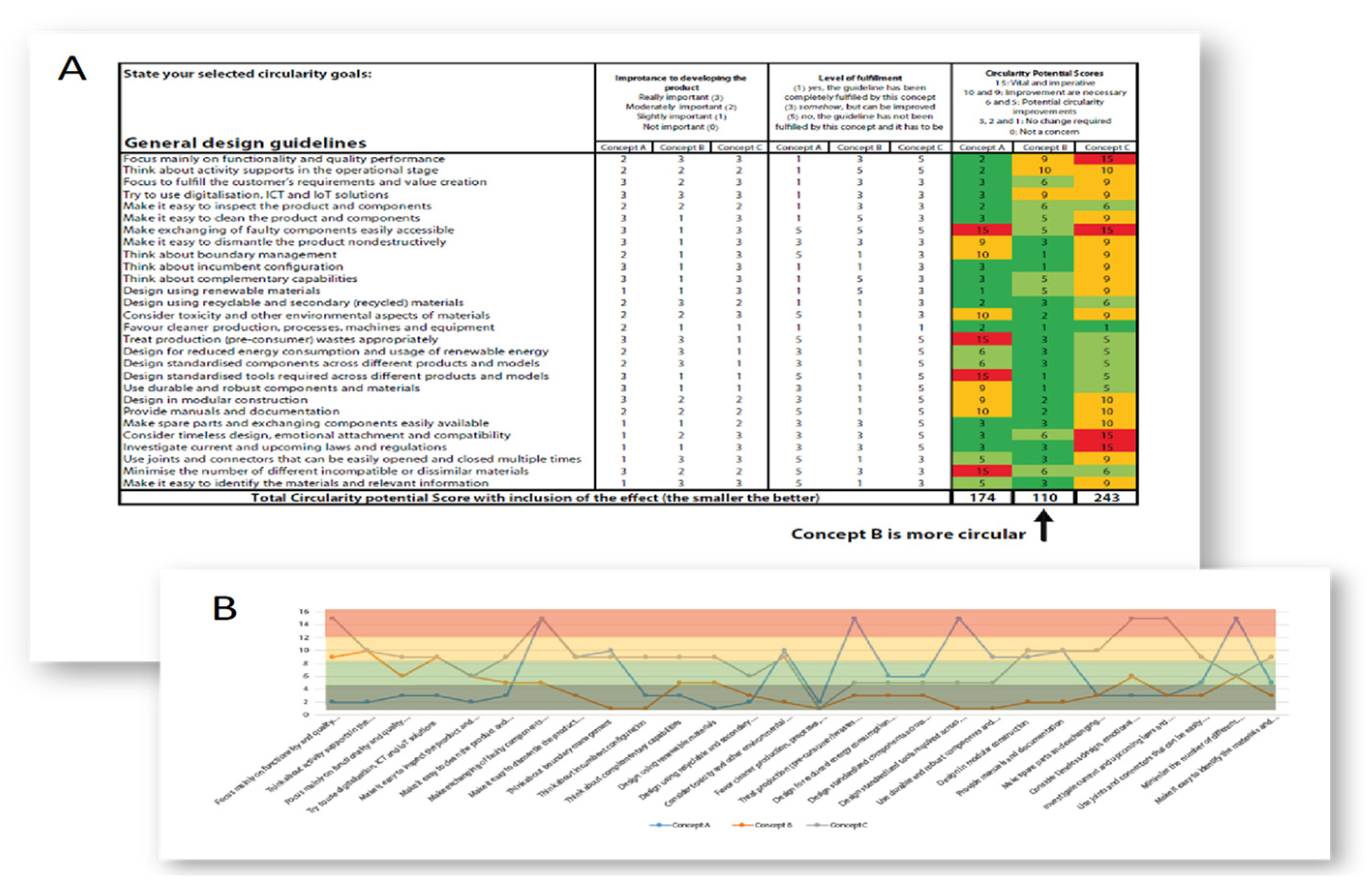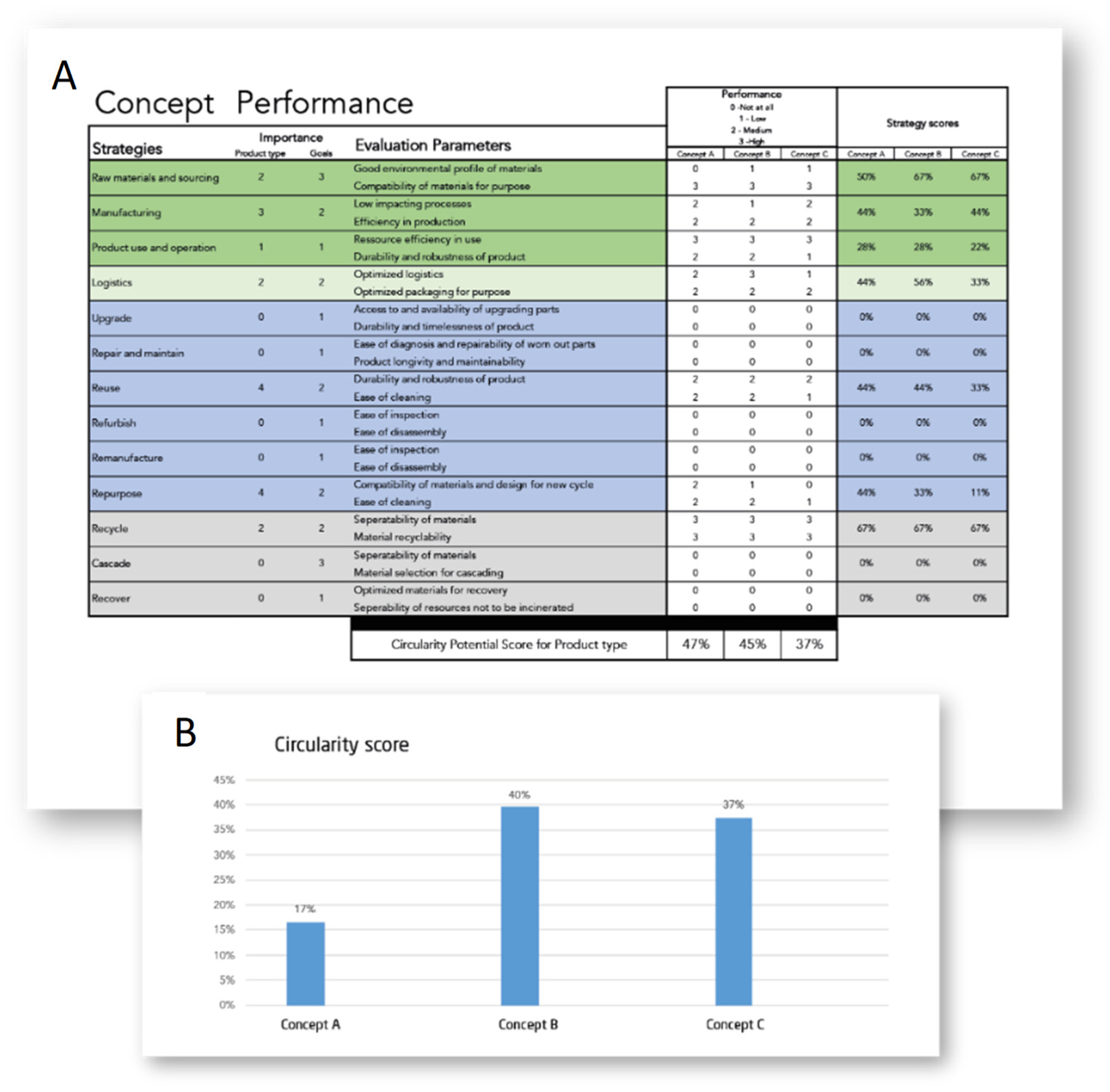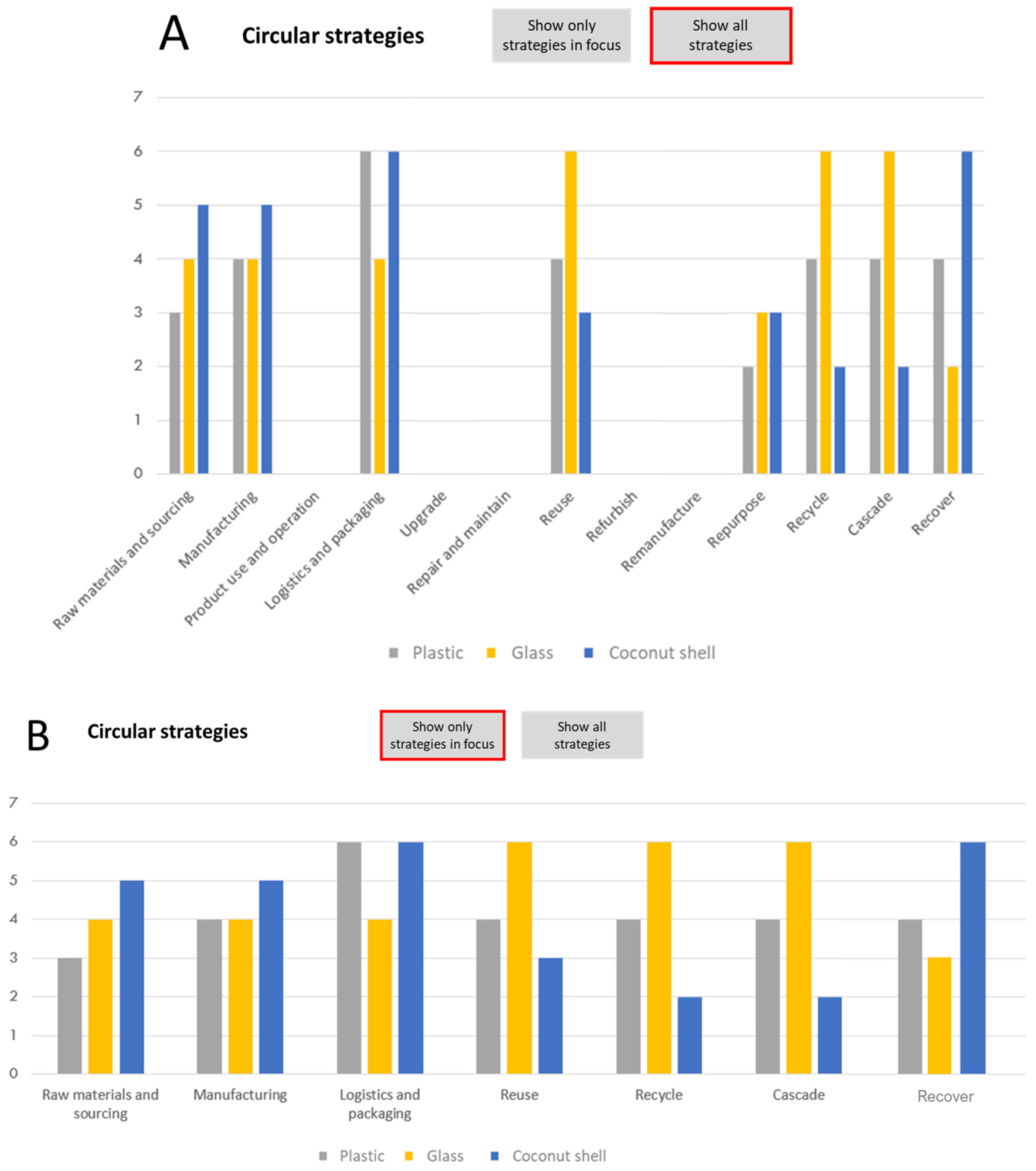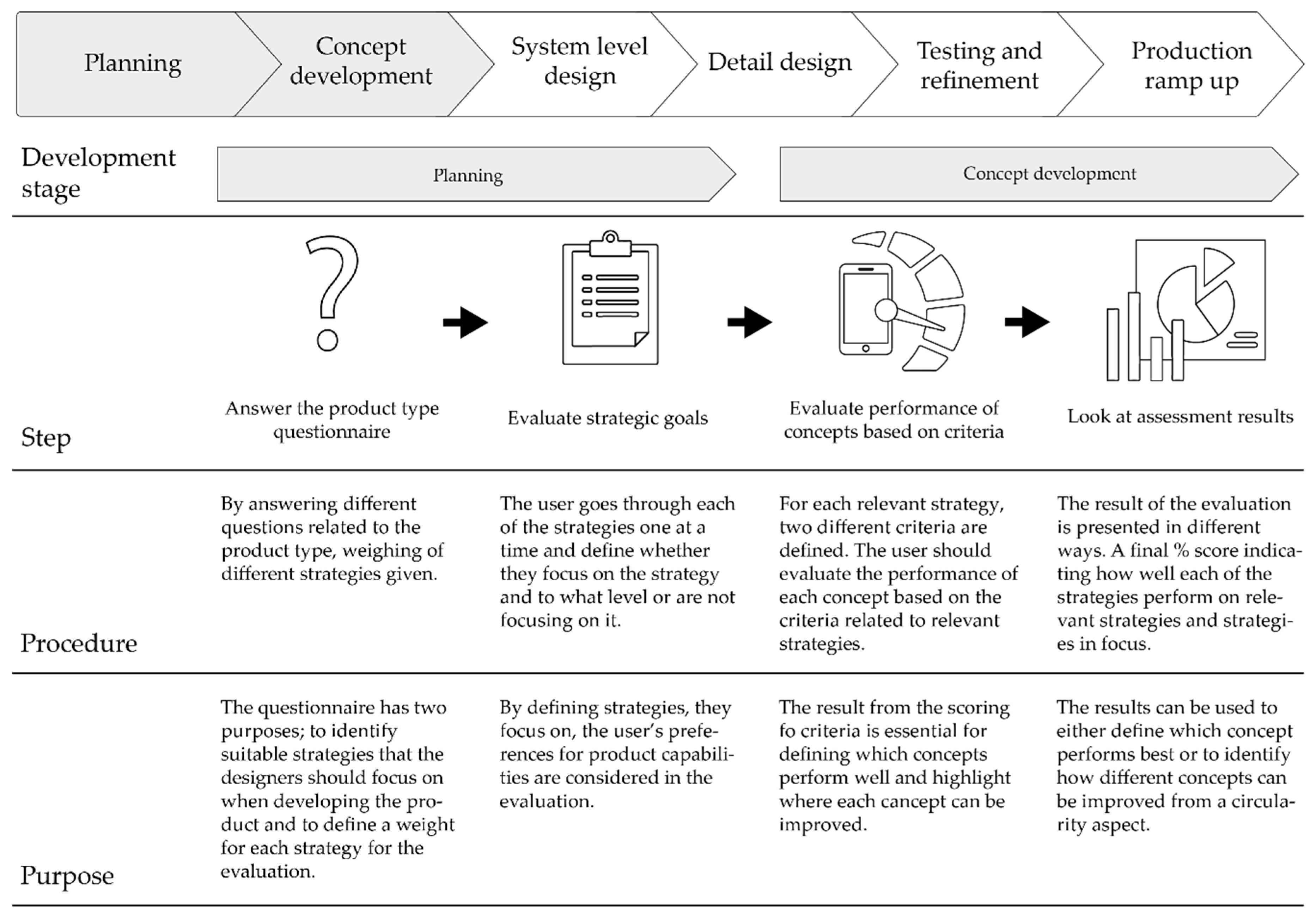Circularity Evaluation of Alternative Concepts During Early Product Design and Development
Abstract
1. Background
2. Research Methodology
3. Theoretical Frame Work
3.1. Circular Product Design
3.2. Evaluating Product Circularity
- Circular economy indicator prototype (CEIP) [40]: A questionnaire-based tool to score points for different phases of the product lifecycle according to the given answers. The result is shown as a product rating and spider web, which indicate the product score in relation to the total score in different phases of the product lifecycle. This can provide an indication of improvement potential but does not indicate directly what product characteristics should be improved.
- Circular economy toolkit (CET) [39]: An online questionnaire-based tool concerning the product’s characteristics and its lifecycle. The tool covers a broad range of circularity loops and provides an indication (opportunity and feasibility) of which areas the product/system perform well in terms of circularity.
- Circularity potential indicator (CPI) [10]: An indicator that uses a top-down approach and evaluates the product circularity based on 20 attributes within four aspects: Circular product design, new business model, reverse cycles, and favorable system conditions. Each attribute can score up to five points, each building block can obtain a score of up to 25, and the total circularity score can reach 100.
- Circular pathfinder (CP) [44]: An online-based tool to be used during product development to find product strategies for improving circularity. The tool goes through questions relating to product type, product customer interactions, lifetime, and user needs, and eventually, suitable strategies are suggested.
4. Success Criteria for a Concept Circularity Evaluation Tool
5. The First Version of the Concept Circularity Evaluation Tool (CCET:v1)
5.1. The Procedure for Applying the CCET:v1
- The level of importance refers to how important the general design guidelines are when designing and developing a specific product; this should be based on the previously selected circular strategies and the determined circularity goals. In this criterion, each general design guideline is given a score from 0 to 3: (3) Really important, (2) moderately important, (1) slightly important, and (0) not important.
- The level of fulfillment refers to how much the general design guidelines are applied/fulfilled for each of the developed concepts. In this criterion, each general design guideline is given a score: (1) Yes, the guideline has been completely fulfilled by this concept; (3) somehow but can be improved; and (5) no, the guideline has not been fulfilled by this concept and it has to be. The level of fulfillment should not be evaluated for guidelines that were given (0) as the level of importance.
- (0): Circularity is not a concern.
- (1–3): Does not require any changes in design and concept.
- (5–6): There is circularity improvement potential in the current design and concept.
- (9–10): Circularity improvements are necessary for the current design and concept.
- (15): Vital and imperative design changes are necessary for circularity.
5.2. Testing the CCET:v1
6. Comparative Analysis of Tools
7. The Second Version of the Concept Circularity Evaluation Tool (CCET:v2)
7.1. Adaptions to the CCET:v1
- (1)
- Guidance for defining the “level of importance”: This adaptation is supported by two questionnaires that define the importance of a strategy in the calculation of circularity potential.
- ○
- Questionnaire 1 helps identify circular product-related strategies based on the product type and lifecycle characteristics (adapted from the circular pathfinder [44]);
- ○
- Questionnaire 2 helps select the most relevant circular strategies for the products under development and define goals (related to the circular strategies) to pursue.
- (2)
- (3)
- Calculation of circularity scores: Contrary to the CCET:v1, a higher circularity score is better in the CCET:v2, indicating that the product concept performs well on the evaluation parameters. Additionally, the circularity scores are given as percentages, indicating the performance relative to the highest possible circularity.
7.2. The Procedure for Applying the CCET:v2
7.3. Testing of the CCET:v2
- Step 1: Product type questionnaire: Interviewees had positive feedback with regard to this questionnaire, which supports the evaluation of the level of importance. According to the feedback, the procedure is well guided and intuitive. However, the tool needs to be transparent in how the strategy scores are generated.
- Step 2: Circular strategic goals: the strategy goal questionnaire was considered one of the most informative and pedagogic parts of the CCET:v2 since it provides overall descriptions of the individual strategies and forces the team to reflect on circular strategic goals for the particular product. However, some confusion regarding definitions and distinguishing among circular strategies, such as reuse, refurbishment, and repurposing, was observed at the workshop with Company D. Therefore, improvements in circular strategy definitions were made to ensure a complete understanding and avoid any further confusion.
- Step 3: Performance levels: Rating the performance levels was generally considered quite intuitive and instructive to understand. However, a technical issue regarding background calculations was pointed out in the workshop with Company D, which was eradicated afterward.
- Step 4: Visualization of results: In general, interviewees at Companies A, B, and C found the results of the evaluation understandable. A general comment pointed out a better and more detailed visualization of the results, particularly for communication purposes with people who were not a part of the evaluation process.
8. Discussion
- Identification of hotspots: The hotspot analysis enables the developers to identify weak points in the concept layout and potentially improve these to achieve a higher circularity;
- Comparison of concepts: The CCET supports the evaluation of the circularity potential of multiple concepts either from a combined circularity point of view or by specific strategies;
- Broad scope of strategies: The CCET includes a broad set of circular strategies, covering both eco-efficiency and eco-effectiveness strategies;
- Hierarchy of recirculation strategies: In the calculation of strategy scores, the CCET integrates a hierarchy of the recirculation strategies, which forces the development team to consider the possibilities of targeting strategies with higher circularity potential (e.g., upgrade, repair, and reuse), as these will enable higher circularity scores;
- Customized evaluation: The tool ensures that concepts are evaluated in a customized way, based on specific product features (e.g., not all products will become more circular by being upgradable);
- Informative, pedagogic, and instructive: The tool contains multiple elements of being pedagogic to the user, such as the guiding toward the definitions and selection of circular strategies;
- Simple and intuitive: The user learns more about the circular strategies and designing for these by using the tool. According to the test feedback, it is indicated that the tool is intuitive, as the user is guided through the process, one-step at a time.
9. Summary and Conclusions
Supplementary Materials
Author Contributions
Funding
Acknowledgments
Conflicts of Interest
References
- Nasr, N.; Russell, J.; Bringezu, S.; Hellweg, S.; Hilton, B.; Kreiss, C.; Von Gries, N. Re-defining Value: The Manufacturing Revolution-Remanufacturing, Refurbishment, Repair and Direct Reuse in the Circular Economy; United Nations Environment Programme: Nairobi, Kenya, 2018. [Google Scholar]
- Ellen MacArthur Foundation. Towards the Circular Economy. Economic and Business Rationale for an Accelerated Transitio—Executive Summary; Ellen MacArthur Foundation: Cowes, UK, 2012. [Google Scholar]
- Directive 2009/125/EC. Directive 2009/125/EC of the European Parliament and of the Council Establishing a Framework for the Setting of Ecodesign Requirements for Energy-related Products. 2009. Available online: https://eur-lex.europa.eu/LexUriServ/LexUriServ.do?uri=OJ:L:2009:285:0010:0035:en:PDF (accessed on 1 November 2020).
- The European Commission. Closing the Loop—An EU Action Plan for the Circular Economy COM/2015/0614. 2015. Available online: https://eur-lex.europa.eu/resource.html?uri=cellar:8a8ef5e8-99a0-11e5-b3b7-01aa75ed71a1.0012.02/DOC_1&format=PDF (accessed on 1 November 2020).
- Pigosso, D.; McAloone, T. How can design science contribute to a circular economy? In Proceedings of the International Conference on Engineering Design, Vancouver, BC, Canada, 21–25 August 2017. [Google Scholar]
- Rouvin, A.; Zhao, A.; Detrois, C.; Chayadi, J.; Kokkonen, K.; Tascioglu, S.; Fallot, S. Unlocking More Value with Fewer Resources: A Practical Guide to the Circular Economy; World Business Council for Sustainable Development (WBCSD) Leadership Program: Geneva, Swizerland, 2016. [Google Scholar]
- Moreno, M.; De los Rios, C.; Rowe, Z.; Charnley, F. A conceptual framework for circular design. Sustainability 2016, 8, 937. [Google Scholar] [CrossRef]
- Pozo Arcos, B.; Balkenende, A.R.; Bakker, C.A.; Sundin, E. Product Design for a Circular Economy: Functional Recovery on Focus. In Proceedings of the DS 92: DESIGN 2018 15th International Design Conference, Dubrovnik, Croatia, 21–24 May 2018; pp. 2727–2738. [Google Scholar]
- Shahbazi, S.; Jönbrink, A.K. Design Guidelines to Develop Circular Products: Action Research on Nordic Industry. Sustainability 2020, 12, 3679. [Google Scholar] [CrossRef]
- Saidani, M.; Yannou, B.; Leroy, Y.; Cluzel, F. How to assess product performance in the circular economy? Proposed requirements for the design of a circularity measurement framework. Recycling 2017, 2, 6. [Google Scholar] [CrossRef]
- Ulrich, K.T.; Eppinger, S.D. Product Design and Development; McGraw-Hill Higher Education: New York, NY, USA, 2008. [Google Scholar]
- Blessing, L.T.M.; Chakrabarti, A. DRM, a Design Research Methodology; Springer: London, UK, 2009. [Google Scholar]
- Dubois, A.; Gadde, L.-E. Systematic combining: An abductive approach to case research. J. Bus. Res. 2002, 55, 553–560. [Google Scholar] [CrossRef]
- Bocken, N.M.P.; de Pauw, I.; Bakker, C.; van der Grinten, B. Product design and business model strategies for a circular economy. J. Ind. Prod. Eng. 2016, 33, 308–320. [Google Scholar] [CrossRef]
- Boks, C.; McAloone, T.C. Transitions in sustainable product design research. Int. J. Prod. Dev. 2009, 9, 429–449. [Google Scholar] [CrossRef]
- Knight, P.; Jenkins, J.O. Adopting and applying eco-design techniques: A practitioners perspective. J. Clean. Prod. 2009, 17, 549–558. [Google Scholar] [CrossRef]
- Rodrigues, V.P.; Pigosso, D.C.A.; McAloone, T.C. Measuring the implementation of ecodesign management practices: A review and consolidation of process-oriented performance indicators. J. Clean. Prod. 2017, 156, 293–309. [Google Scholar] [CrossRef]
- Pigosso, D.C.A.; McAloone, T.C.; Rozenfeld, H. Systematization of best practices for ecodesign implementation. In Proceedings of the DS 77: DESIGN 2014 13th International Design Conference, Dubrovnik, Croatia, 19–22 May 2014; pp. 1651–1662. [Google Scholar]
- Maccioni, L.; Borgianni, Y.; Pigosso, D.C. Can the choice of eco-design principles affect products’ success? Des. Sci. 2019, 5, e25. [Google Scholar] [CrossRef]
- Hauschild, M.Z.; Rosenbaum, R.K.; Olsen, S.I. Life Cycle Assessment: Theory and Practice; Springer: Basel, Switzerland, 2017. [Google Scholar]
- Kuo, T.-C.; Huang, S.H.; Zhang, H.-C. Design for manufacture and design for ‘X’: Concepts, applications, and perspectives. Comput. Ind. Eng. 2001, 41, 241–260. [Google Scholar] [CrossRef]
- Go, T.; Wahab, D.A.; Hishamuddin, H. Multiple generation life-cycles for product sustainability: The way forward. J. Clean. Prod. 2015, 95, 16–29. [Google Scholar] [CrossRef]
- Mendoza, J.M.F.; Sharmina, M.; Gallego-Schmid, A.; Heyes, G.; Azapagic, A. Integrating backcasting and eco-design for the circular economy: The BECE framework. J. Ind. Ecol. 2017, 21, 526–544. [Google Scholar] [CrossRef]
- Vezzoli, C.; Manzini, E. Design for Environmental Sustainability; Springer: London, UK, 2008. [Google Scholar]
- Branowski, B.; Zabłocki, M.; Sydor, M. The Material Indices Method in the Sustainable Engineering Design Process: A Review. Sustainability 2019, 11, 5465. [Google Scholar] [CrossRef]
- Battaïa, O.; Dolgui, A.; Heragu, S.S.; Meerkov, S.M.; Tiwari, M.K. Design for Manufacturing and Assembly/Disassembly: Joint Design of Products and Production Systems; Taylor & Francis: Abingdon-on-Thames, UK, 2018. [Google Scholar]
- Soh, S.; Ong, S.; Nee, A. Design for assembly and disassembly for remanufacturing. Assem. Autom. 2016, 36, 12–24. [Google Scholar] [CrossRef]
- Sundin, E. Product and Process Design for Successful Remanufacturing; Linköping University Electronic Press: Linköping, Sweden, 2004. [Google Scholar]
- Lindkvist Haziri, L.; Sundin, E.; Sakao, T. Feedback from Remanufacturing: Its Unexploited Potential to Improve Future Product Design. Sustainability 2019, 11, 4037. [Google Scholar] [CrossRef]
- Hultgren, N. Guidelines and Design Strategies for Improved Product Recyclability-How to Increase the Recyclability of Consumer Electronics and Domestic Appliances through Product Design. Available online: http://publications.lib.chalmers.se/records/fulltext/166740.pdf (accessed on 1 November 2020).
- Hu, Q.; Peng, Y.; Guo, C.; Cai, D.; Su, P. Dynamic Incentive Mechanism Design for Recycling Construction and Demolition Waste under Dual Information Asymmetry. Sustainability 2019, 11, 2943. [Google Scholar] [CrossRef]
- Blomsma, F.; Pieroni, M.; Kravchenko, M.; Pigosso, D.; Hildenbrand, J.; Kristinsdottir, A.R.; Kristoffersen, E.; Shabazi, S.; Nielsen, K.D.; Jönbrink, A.-K.; et al. Developing a circular strategies framework for manufacturing companies to support circular economy oriented innovation. J. Clean. Prod. 2019, 241, 118271. [Google Scholar] [CrossRef]
- Bovea, M.D.; Pérez-Belis, V. Identifying design guidelines to meet the circular economy principles: A case study on electric and electronic equipment. J. Environ. Manag. 2018, 228, 483–494. [Google Scholar] [CrossRef]
- Ellen MacArthur Foundation. The Circular Design Guide. Available online: https://www.circulardesignguide.com/ (accessed on 1 November 2020).
- Elia, V.; Gnoni, M.G.; Tornese, F. Measuring circular economy strategies through index methods: A critical analysis. J. Clean. Prod. 2017, 142, 2741–2751. [Google Scholar] [CrossRef]
- Linder, M.; Sarasini, S.; van Loon, P. A metric for quantifying product-level circularity. J. Ind. Ecol. 2017, 21, 545–558. [Google Scholar] [CrossRef]
- Ellen MacArthur Foundation. Circularity Indicators: An Approach to Measuring Circularity-Methodology; Ellen MacArthur Foundation: Cowes, UK, 2015. [Google Scholar]
- Franklin-Johnson, E.; Figge, F.; Canning, L. Resource duration as a managerial indicator for Circular Economy performance. J. Clean. Prod. 2016, 133, 589–598. [Google Scholar] [CrossRef]
- Evans, J.; Bocken, N. Circular Economy Toolkit. Available online: http://circulareconomytoolkit.org/ (accessed on 1 November 2020).
- Griffiths, P.; Cayzer, S. Design of indicators for measuring product performance in the circular economy. In Proceedings of the International Conference on Sustainable Design and Manufacturing, Budapest, Hungary, 4–5 July 2019; pp. 307–321. [Google Scholar]
- Kravchenko, M.; Pigosso, D.C.A.; McAloone, T.C. Towards the ex-ante sustainability screening of circular economy initiatives in manufacturing companies: Consolidation of leading sustainability-related performance indicators. J. Clean. Prod. 2019, 241, 118318. [Google Scholar] [CrossRef]
- Parchomenko, A.; Nelen, D.; Gillabel, J.; Rechberger, H. Measuring the circular economy-A Multiple Correspondence Analysis of 63 metrics. J. Clean. Prod. 2019, 210, 200–216. [Google Scholar] [CrossRef]
- Kravchenko, M.; Pigosso, D.C.; McAloone, T.C. A Procedure to Support Systematic Selection of Leading Indicators for Sustainability Performance Measurement of Circular Economy Initiatives. Sustainability 2020, 12, 951. [Google Scholar] [CrossRef]
- ResCoM. Available online: https://www.rescoms.eu/ (accessed on 4 April 2020).
- Boorsma, N.; Peck, D.; Fischer, S.; Bakker, C.; Balkenende, R. Remanufacturing workshops with professionals to overcome barriers-outcomes of two eu projects. In Proceedings of Concerence Going Green—Care Innovation 2018, Vienna, Austria, 26–29 November 2018. [Google Scholar]






| Research Clarification (RC) | |
|---|---|
Main activities
| Main outcome
|
| Descriptive study I (DS I) | |
Main activities
| Main outcome
|
| Prescriptive study I (PS I) | |
Main activities
| Main outcome
|
| Descriptive Study II (DS II) | |
Main activities
| Main outcome
|
| Prescriptive Study II (PS II) | |
Main activities
| Main outcome
|
| Descriptive Study III (DS III) | |
Main activities
| Main outcome
|
| Prescriptive Study III (PS III) | |
Main activities
| Main outcome
|
| Success Criteria | Brief Description |
|---|---|
| Identify hotspots | The tool should be able to identify circularity hotspots. Hotspots are key areas that highly influence or define the circularity of a concept, both positive and negative aspects. The identification of hotspots is a key feature to implement in the evaluation tool, as it guides the user to improve the evaluated concepts. |
| Comparison of concepts | Several concepts are usually developed and evaluated in the early product design and development process. It is therefore deemed highly useful that the tool can be applicable in a comparative analysis, which can also enable inspiration to be drawn from one concept to another, leading to the improvement of existing concepts and/or development of new concepts. |
| Broad scope of strategies | The path toward a circular economy contains multiple strategies [32], and each of these strategies should be included in an evaluation tool. The tool should be able to capture the whole picture of the circular economy including recirculation strategies (e.g., upgrade, repair, reuse, and recycle), resource efficiency strategies (e.g., material sourcing), and business-model-related strategies (e.g., rethink and reinvent), which is exactly the opposite of many existing tools that focus only on single aspects of circularity (e.g., recycling rates). |
| Hierarchy of recirculation strategies | A tool for evaluating concept circularity should be able to differentiate different recirculation strategies (loops) and address different levels of their contribution to circularity (which is based on value loss). For example, most often, recycling or energy recovery is the least preferred strategy, while repairing and upgrading products is often more beneficial and preferred (see [32] for a complete hierarchy of the recirculation strategies, which include all the circular strategies related to recirculating products, parts, and material, e.g., upgrading, refurbishing and recycling) |
| Customized evaluation | The evaluation of a product in terms of circularity should be based on the characteristics and features of the product. A product characteristic (e.g., durability) might be relevant to product A but not to product B. In the very early stages of product development, different concepts for a product might not necessarily follow the same characteristics; for instance, concept A might focus on durability with the selection of robust material type and less diversity of materials, while concept B might focus on durability with the exchangeability of components. This highlights the importance of designing to ‘fit the purpose’. |
| Informative, pedagogic and instructive | The main goal of the circularity evaluation tool is to support decision making in the early stages of product design and development, which means finding circularity improvement potential in product concepts. Additionally, being informative, pedagogic, and instructive can be seen as the secondary goal of such a tool for the purpose of helping users understand circularity as a whole, think circular, and learn for future projects. |
| Simple and intuitive | Product design and development engages several functions including designers, engineers and manufacturing representatives, research and development professionals, purchase and procurement staff, product owners, sales and marketing, general management, lifecycle assessment experts, and environmental coordinators. Hence, the tool should be simple and intuitive, with no confusion in use, understanding, and communicating the results. |
| Criterion | CEIP | CET | CPI | CCET:v1 |
|---|---|---|---|---|
| Identifying hotspots | + | + | ++ | +++ |
| Comparison of concepts | + | + | + | +++ |
| Broad scope of strategies | ++ | ++ | +++ | +++ |
| Hierarchy of recirculation strategies | 0 | 0 | 0 | 0 |
| Customized evaluation | 0 | 0 | 0 | ++ |
| Informative, pedagogic, and instructive | 0 | 0 | 0 | + |
| Simple and intuitive | +++ | +++ | +++ | + |
| Circular Strategies [32] | Guidelines [9] | Parameters |
|---|---|---|
| Raw materials andsourcing |
|
|
| Manufacturing |
|
|
| Product use and operation |
|
|
| Logistics and packaging |
|
|
| Upgrade |
|
|
| Repair and maintenance |
|
|
| Reuse |
|
|
| Refurbishment |
|
|
| Remanufacturing |
|
|
| Repurpose |
|
|
| Recycling |
|
|
| Cascade |
|
|
| Recover |
|
|
| Questions | Alternative Answers |
|---|---|
| What is the approximate lifetime (initial life) of this type of product? | Single-use product; short-life product (up to 2 years); Medium-life product (2–10 years); Long-life product (more than 10 years) |
| What is the primary reason that the user disposes of the product? | No longer functional; Outdated (either esthetically or functionally); Degraded visually or functionally; No longer needed (including single-use products) |
| Are there any other reasons that users dispose of the product? | No secondary reason: It is no longer functional; Outdated (either esthetically or functionally); Degraded visually or functionally; No longer needed (including single-use products) |
| After the initial use, is the product still usable or can it be returned to usable condition? | Yes, the product is still in very good condition; Yes, the product can return to good condition by being fixed; No, many/most components are worn out |
| Many products that use fuel or electricity have a high impact in the use stage. Additionally, products that require chemicals or energy for cleaning will have an impact in the use stage. Are there large impacts in the use stage for this product type? | Yes, the product uses many resources in the use stage; It uses some resources in the use stage; No, the product has no significant impact in use |
| Does energy efficiency or functional capability change significantly across generations of products? | Yes, the efficiency of the product change fast; Yes, new products have significantly new capabilities; Yes, both efficiency and capability increase; No, the product does not change efficiency or capability across generations |
| Could there be a market for second-hand/reused or repaired versions of these products? | Yes, many of these products could have or have a second life; Yes, there could be some interest in reused products; No, there is not interest in used products |
| Can the product or its parts be used for something else, which replaces other products or components, after its initial life (not for the same product)? | Yes, most of the product can be repurposed; Some parts can be repurposed; No parts can be repurposed |
| Does the product typically contain high-impact, rare materials or toxic materials? | Yes, highly; Yes, to some extent; No, close to none |
| Does the production of this type of product often include processes that are high-impact? | Yes, generally high-impact; Neither high- nor low-impact; No, generally low-impact processes |
| Could the product lifetime be improved if specific components are replaced (by the same or better performing components)? | No, the lifetime cannot be improved in this way; Yes, exchanging specific components can improve product life; Yes, but it requires taking most of the product apart and changing multiple parts |
| Is the product typically heavily packaged and transported? | Very little transport and packaging; Highly packaged but only short transport; Long transport but little packaging; Both highly packaged and long transport |
| For some products, recycling is not a viable option for end of life treatment. This can be due to the contamination of the product during use or resources used for collection and recycling of product. Is the recycling of most of the product possible? | No, recycling cannot be made beneficial at all; Yes, but only recycling to a lower grade is possible (cascading); Yes, recycling can be beneficial |
| Is there a risk that some products or parts of the product will be cascaded (recycled to a lower grade) or recovered (incinerated or biodegraded)? | No, the whole product is recycled; Yes, some components or whole product might be cascaded; Yes, some components or whole product might be used for energy recovery; Yes, both cascading and recovery might happen |
Publisher’s Note: MDPI stays neutral with regard to jurisdictional claims in published maps and institutional affiliations. |
© 2020 by the authors. Licensee MDPI, Basel, Switzerland. This article is an open access article distributed under the terms and conditions of the Creative Commons Attribution (CC BY) license (http://creativecommons.org/licenses/by/4.0/).
Share and Cite
Kamp Albæk, J.; Shahbazi, S.; McAloone, T.C.; Pigosso, D.C.A. Circularity Evaluation of Alternative Concepts During Early Product Design and Development. Sustainability 2020, 12, 9353. https://doi.org/10.3390/su12229353
Kamp Albæk J, Shahbazi S, McAloone TC, Pigosso DCA. Circularity Evaluation of Alternative Concepts During Early Product Design and Development. Sustainability. 2020; 12(22):9353. https://doi.org/10.3390/su12229353
Chicago/Turabian StyleKamp Albæk, Julie, Sasha Shahbazi, Tim C. McAloone, and Daniela C. A. Pigosso. 2020. "Circularity Evaluation of Alternative Concepts During Early Product Design and Development" Sustainability 12, no. 22: 9353. https://doi.org/10.3390/su12229353
APA StyleKamp Albæk, J., Shahbazi, S., McAloone, T. C., & Pigosso, D. C. A. (2020). Circularity Evaluation of Alternative Concepts During Early Product Design and Development. Sustainability, 12(22), 9353. https://doi.org/10.3390/su12229353







